Sacramento, CA Pollen and Allergy Report for Summer 2023
Pollen Allergy Trends in Sacramento, CA
When is pollen lowest in Sacramento, CA?

February
Lowest month total PPM
Avg. PPM
When is pollen highest in Sacramento, CA?

April
Highest month total PPM
Avg. PPM
How does pollen in Sacramento, CA compare to California?
Sacramento has a lower average PPM than the state of California.
Sacramento yearly avg PPM:
California yearly avg PPM:
How does pollen in Sacramento, CA compare to the USA?
Sacramento has a lower average PPM than the USA.
Sacramento yearly avg PPM:
USA yearly avg PPM:
Is pollen worse this year in Sacramento, CA?
Spring 2023 was worse than spring 2022.
Spring 2023 PPM:
Spring 2022 PPM:
Average PPM in Sacramento, CA
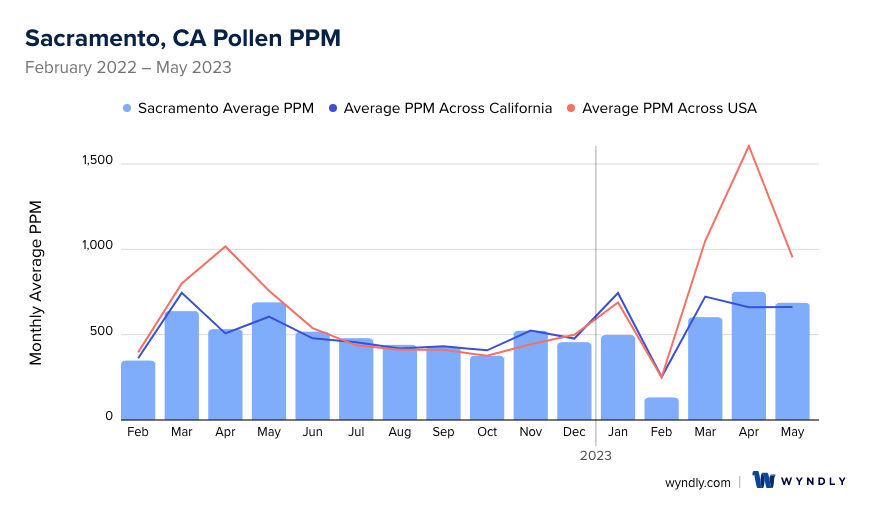

Sacramento, CA Pollen and Allergy Breakdown by Month
Grass
When is grass pollen highest in Sacramento, CA?
May has the highest grass pollen in Sacramento, CA with an average PPM of
When is grass pollen lowest in Sacramento, CA?
December has the lowest grass pollen in Sacramento, CA with an average PPM of
Tree
When is tree pollen highest in Sacramento, CA?
April has the highest tree pollen in Sacramento, CA with an average PPM of
When is tree pollen lowest in Sacramento, CA?
August has the lowest tree pollen in Sacramento, CA with an average PPM of
Weed
When is weed pollen highest in Sacramento, CA?
November has the highest weed pollen in Sacramento, CA with an average PPM of
When is weed pollen lowest in Sacramento, CA?
February has the lowest weed pollen in Sacramento, CA with an average PPM of
Sacramento, CA Pollen Monthly Breakdown by Pollen Type
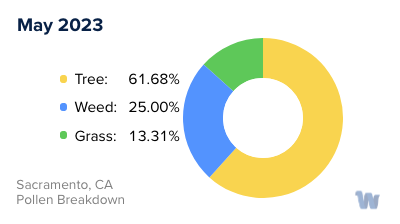

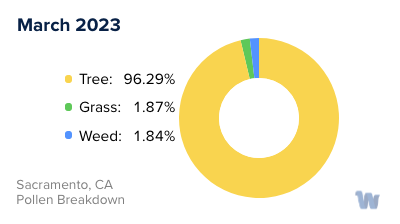



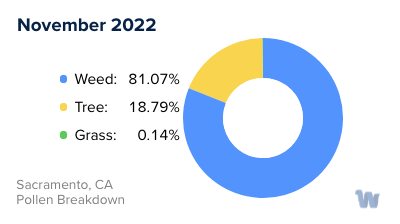
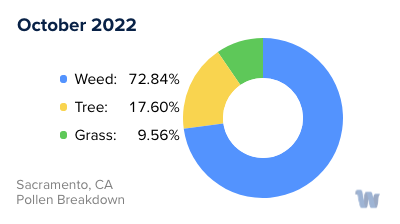


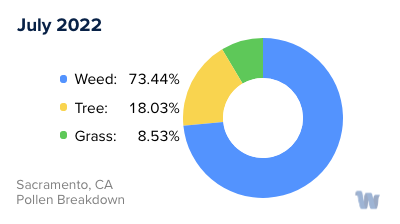
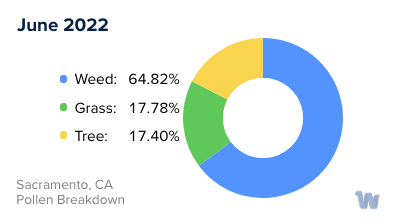




Pollen and Hay Fever in Sacramento, CA
Pollen allergies, often referred to as hay fever or seasonal allergies, are a common health concern for many residents of Sacramento, California. These allergies are typically triggered by the pollen released by a variety of plants during their respective blooming seasons. When this pollen enters the nose of someone who's allergic, it triggers an immune response that results in the classic symptoms of hay fever: sneezing, runny or stuffy nose, itchy or watery eyes, and an itchy throat or ears.
In Sacramento, a city with a diverse range of flora, several types of pollen are prevalent. The city’s Mediterranean climate, characterized by wet winters and hot, dry summers, encourages the growth of different plant species that release pollen at various times of the year.
Oak pollen, for instance, is typically released in the spring and is one of the most potent allergens in the region. The city's many oak trees, particularly the native California Live Oak, can cause significant discomfort for allergy sufferers during this time.
Grass pollen, on the other hand, tends to peak in late spring and early summer. Common grasses in Sacramento that produce allergenic pollen include ryegrass, Bermuda grass, and Timothy grass.
Additionally, weed pollen, particularly from plants like ragweed and sagebrush, comes into play in late summer and fall. These plants, although less common in city landscapes, thrive in the surrounding areas and their lightweight pollen can travel long distances on the wind, affecting Sacramento residents.
While the timing can vary slightly from year to year, these general patterns hold true. In Sacramento, the overlapping seasons of different pollens mean that some people might experience hay fever symptoms for a large part of the year, while others might be affected only during a particular pollen season, depending on their specific sensitivities.
Understanding the types of pollen and their seasons is the first step towards managing pollen allergies. Armed with this knowledge, those affected can make informed decisions about their daily routines, limiting outdoor activities during peak pollen times or on days when the pollen count is particularly high.

